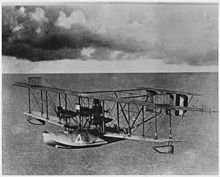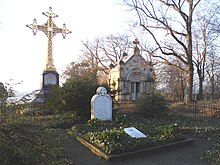RAF Mount Batten
The RAF Mount Batten was a Royal Air Force base and base for flying boats on Mount Batten , a peninsula in Plymouth Bay , Devon, England. Originally a seaplane base , established in 1917 as Royal Navy Air Service Station Cattewater , it became RAF Cattewater in 1918 and renamed RAF Mount Batten in 1928 . From then on, at the latest, the motto of the station was “In Honor Bound”.
Today not much is reminiscent of this former RAF base, apart from aviation-related street names and two hangars from 1917.
history
First military use: Mount Batten
In 1644 William Batten (c. 1600), from 1638 Inspector of the Royal Navy, built a 10 meter high gun turret on the Cattewater Peninsula to secure the port entrance of Plymouth .
As a result, the entire peninsula was named Mount Batten . Although the Prince of Wales had meanwhile knighted, Batten had to give up his office in 1648 at the instigation of royalist circles and retired into private life. In 1660 he was rehabilitated and again first inspector of the Royal Navy until his death in 1667.
As early as 1913, the sheltered bay of Cattewater was used for tests with flying boats, and in 1916 it was decided to create a base for flying boats of the Royal Navy. In February 1917, the RNAS Cattewater was opened. It had an aircraft hangar, storage shed, and a brick pier with rail tracks on which a steam-powered crane could travel and launch the planes. Cattewater was now not only a test base, it was also an official flight operations, mostly for coastal patrols.
Royal Air Force Station Cattewater
With the establishment of the British Royal Air Force in April 1918, the base became the RAF Cattewater . After the end of the First World War it was little used, but came into the public eye in 1919 with the arrival of the Curtiss NC 4 , which was the first aircraft to cross the Atlantic. From 1923 the station was repaired and expanded and reopened in 1928.
Royal Air Force Station Mount Batten
On October 1, 1928, after completion of the construction work, the former Cattewater flying boat base was reopened under the name RAF Mount Batten . The main task of the newly opened base was the guarding and defense of southwest England with flying boats.
The base also became a base for sea rescue flights, in which an Aircraftsman Shaw was on duty in 1922 - better known as TE Lawrence or Lawrence of Arabia , who had initially proposed the name change with the motto "In Honor Bound". He wrote a book about his service here: The Mint , in German under the mint stick , in which he sharply denounced the drill in the British military. An outstanding and formative (sic!) Event at that time was the crash of a flying boat, which was caused by a senior officer giving a flight captain incorrect instructions to land and forcing them to be carried out. The lifeboats leaving Cattewater Base for the rescue, referred to by Lawrence as "Lame Ducks", were too late for the rescue. As a result, the regulation of the absolute decision-making power of the pilot, which was demanded by Lawrence and now internationally introduced, was introduced at the RAF and Lawrence set about developing faster, operational lifeboats.
Lifeboat development
With the beginning of the Second World War , flight operations at the Mount Batten base increased significantly. He was also the target of several German air strikes that led to the destruction of one of the hangars on November 28, 1940.
After the end of the Second World War, the Australian units (RAAF No. 10 & No. 461) stationed here since 1941 and equipped with Short Sunderland flying boats returned home and RAF Mount Batten became the maintenance and repair base. At the end of the 1950s, an RAF school for watercraft was established; from 1961 it was the main base of the maritime department of the RAF. Although it did not have its own aircraft, it remained the headquarters of the sea pilots until this branch of the RAF was closed in 1986, as did the survival training school until it left in 1992.
literature
- TE Lawrence : Under the die - The Mint. List, Munich 1990, ISBN 3-471-78047-5 .
Worth mentioning
Prince Ludwig Alexander von Battenberg joined the Royal Navy in Plymouth in 1868 as a midshipman at the age of 14 , advanced to admiral and became First Sea Lord in 1912 . When the war broke out in 1914, he was forced to resign because of his German descent. When the English royal family changed their German title to Windsor on September 17, 1917 , he did the same at the request of the English king, discarded all German titles and changed his name to "Louis Mountbatten", and received as compensation for the lost Germans Title that of the 1st Marquess of Milford Haven . From now on, he used the motto In Honor Bound in his coat of arms
After the end of the war in 1918, he was formally discharged from the Royal Navy against his will and from 1919 got into financial difficulties, so that in 1920 he had to sell his parents' house, Heiligenberg Castle in Hesse . He was rehabilitated early 1921 when it became Knight Grand Cross of the Order of the Bath awarded in the military class and was established in August to Grand Admiral ( Admiral of the Fleet appointed). A month later he died in London of heart failure due to influenza . He was buried in Whippingham on the Isle of Wight.
His grave is adorned there with a scaled-down copy of the “golden cross”, which is reminiscent of his grandmother Wilhelmine von Baden and was erected in 1865/66, the last work of the Darmstadt court sculptor JBScholl.
Web links
Description of the base on the RAF-Web , accessed on October 28, 2015. Report on the plane crash and historical base pictures , accessed on October 28, 2015.
Coordinates: 50 ° 21 '32 " N , 4 ° 7' 48" W.




